WEATHER on the THE WEST SIDE OF SOUTH VANCOUVER ISLAND, BC
These are Weather Network regional links. Click on the town name for current weather conditions.
Weather Notes:
Friday, August 31 ~ The worst of the smoky skies due to wildfires burning in BC seems to be behind us for this summer season. The Air Quality Health Index is at 2 today (very low risk), heading into the Labour Day long weekend.
Wednesday, August 22 ~ WEST SHORE. We’re in for another day of extreme air quality risk today, Wednesday August 22. This means staying indoors when possible (with windows shut to keep out the polluted air) or heading to a community facility or shopping mall that is air conditioned.
Everyone is affected by these high levels of air contaminants, in particular seniors, very young children and those with heart and lung conditions or anyone with a chronic illness that challenges overall body function.

By tomorrow, the level is expected to drop to 5 which is Moderate, in both the West Shore and Victoria/Saanich.
The 10+ levels have resumed in the BC mainland interior area today. Details posted at www.bcairquality.ca
How to read the chart (from left): Current | Today | Tonight | Tomorrow
Tuesday, August 21 ~ GREATER VICTORIA. As of 6:04 pm this evening, Tuesday August 21, there is still a Very High Risk air quality statement for Greater Victoria (noted as Victoria/Saanich and WestShore recordings by Environment Canada).
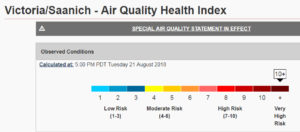
However, the BC Air Quality website says the level will be 10+ overnight, with a reduction still to only 8 (High) on Wednesday. The temperature for August 22 on the west shore is a high of 22°C feeling like 25°C (The Weather Network).
Today the interior had less smoky skies concerns, but on Wednesday theirs will apparently worsen again as the coastal areas clear up a bit.
For general information about wildfire smoke and your health, contact HealthLink BC at 8-1-1 (toll free, 24 hours a day, 7 days a week).
Stay inside if you have breathing difficulties. Find an indoor place that’s cool and ventilated. Using an air conditioner that cools and filters air may help. If you open the windows (or leave air exchangers in full operation) you may let in more polluted air. If your home isn’t air-conditioned, consider going to a public place (library, shopping mall, recreation centre) that is air-conditioned (cooler and filtered).
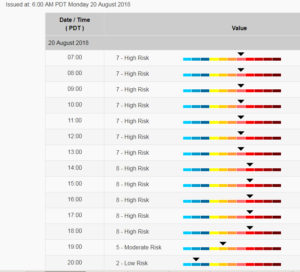
That’s expected to subside to Moderate Risk (Level 5) by 7 pm this evening, and to Low Risk (Level 2) by 10 pm.
Smoky skies will continue across most of the province for the next few days. https://weather.gc.ca/airquality/pages/next18Hourlies/bcaq-010_e.html
Full article here: https://islandsocialtrends.ca/?page_id=12999

Thursday, August 16 ~ GREATER VICTORIA. The Air Quality Health Index by Environment Canada is down to 3 today (scale of 1 to 10), for the Greater Victoria area today August 16.
This is significantly lower than in previous days.
Generally speaking, this is considered sufficiently good air quality for normal outdoor activities for seniors, young children, and anyone with heart/lung and breathing challenges.

That’s listed as ‘moderate risk’ (at the top of the 4 to 6 range), though yesterday health officials were calling the smoke levels ‘high risk’. The forecast shows the Air Quality Health Index could reach 7 (7 to 10 is officially High Risk) in the next 18 hours.
Seniors, young children, and anyone with lung, heart or chronic health disorders can find breathing to be more difficult when the air quality is poor. Reducing strenuous activities outdoors is applicable to everyone under these conditions.
The smoky skies are a result of wildfires burning in north-central BC and on Vancouver Island. A ridge of high pressure is preventing the dispersal of the smoke from the south-island region.
The smoke may contain some degree of chemicals from the fire retardants used to battle the wildfires.
According to the BC Ministry of Forests, Lands, Natural Resource Operations and Rural Development, fire retardants, foam and water can all be used to slow down a fire’s growth. They support the efforts of ground crews in containing the fire. Water-soluble fire retardants are commonly used in fire suppression because of their long-lasting effect on fires. They contain ammonium salts which affect the burning process of forest fuels. The fire retardant liquid concentrate is mixed with water at a ratio of 5.5 parts water to one part concentrate to form the working solution. Retardant has a much longer-lasting effect than water in fire suppression because it does not evaporate. On average, about 9.4 million litres of fire retardant is used each fire season in BC.
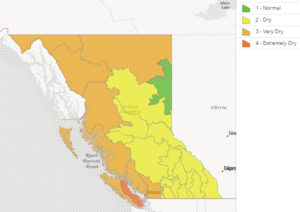
As a result, a maximum reduction of water use is recommended and regulatory action may become necessary.
The west side of Vancouver Island remains at Level 3 and will be re-evaluated as conditions deteriorate, the government says.
A map of the affected areas is available online: http://ow.ly/BY7z30lpdi0
The Province is urging all surface water and groundwater users, including residents, industry, farmers and municipalities, to voluntarily reduce water consumption.
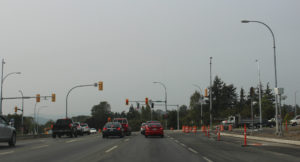
In Greater Victoria today, daytime road traffic was lighter than usual. Many people were indoors where possible, as even those without chronic health conditions can feel the impact of breathing air containing the smoke particles.
The air quality index is at High for large areas of the province. Seniors, young children, and anyone with lung, heart or chronic health disorders can find breathing to be more difficult when the air quality is poor. Reducing strenuous activities outdoors is applicable to everyone under these conditions.
A lack of wind in the forecast means the intense level of smoke is likely to continue for the next few days, according to Environment Canada. A light westerly wind is in the forecast for Thursday.
As of 6 am this morning, Victoria was at level 4 on the 1-10 air quality health index scale. By 9 pm the level had reached 6. The Island Health Smoky Skies Bulletin August 14 included ‘West Vancouver Island’ (Tofino, Uclulet, Port Renfrew, Sooke) and ‘Greater Victoria’ (includes Sidney, Victoria, Saanich, Langford, Metchosin).
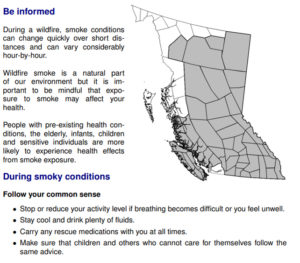
Island Health says to stay cool and drink plenty of water. Reduce indoor air pollution sources such as smoking, burning candles and frying foods. And to carry ‘rescue medications’. Also, to be sure that children and others with health needs are given the same level of care and attention regarding any impacts from the higher level of smoke.
The full Island Health Smoky Skies Bulletin of August 14 is here: https://www2.gov.bc.ca/assets/gov/environment/air-land-water/air/advisories/2018-08-14_smoky_skies_amended.pdf .
Another stretch of hot weather in the forecast to start Sunday July 22 through July 31.
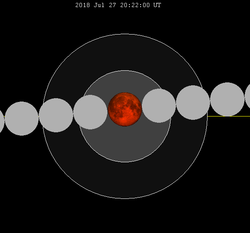 Thursday, July 26. There will be a total lunar eclipse on Friday July 27. It will be visible in areas of Australia, Asia, Africa, Europe and South America, but not in North America. Totality will last 103 minutes… the longest such eclipse of the 21st century.
Thursday, July 26. There will be a total lunar eclipse on Friday July 27. It will be visible in areas of Australia, Asia, Africa, Europe and South America, but not in North America. Totality will last 103 minutes… the longest such eclipse of the 21st century.
In North America the eclipse will not be visible. If you plan to watch the livestream on July 27, the totality phase starts at 12:30 pm PDT and peaks at 1:21 pm PDT. The full eclipse period runs from 10:14 am Pacific Time, with a peak at 1:21 pm, through its full cycle by 4:28 pm. Livestream: https://www.timeanddate.com/live/
This impressive duration of this eclipse will result in the Moon itself looking a little smaller and dimmer than usual.
Blue light bends more than red, and gets scattered out. So the light that the atmosphere projects on the Moon is red, giving it a blood-red glow and hence earning the Blood Moon moniker.
In North America on Friday night, Mars will be visible and especially bright in a full moon sky … easy to see without binoculars or telescope, weather permitting.








